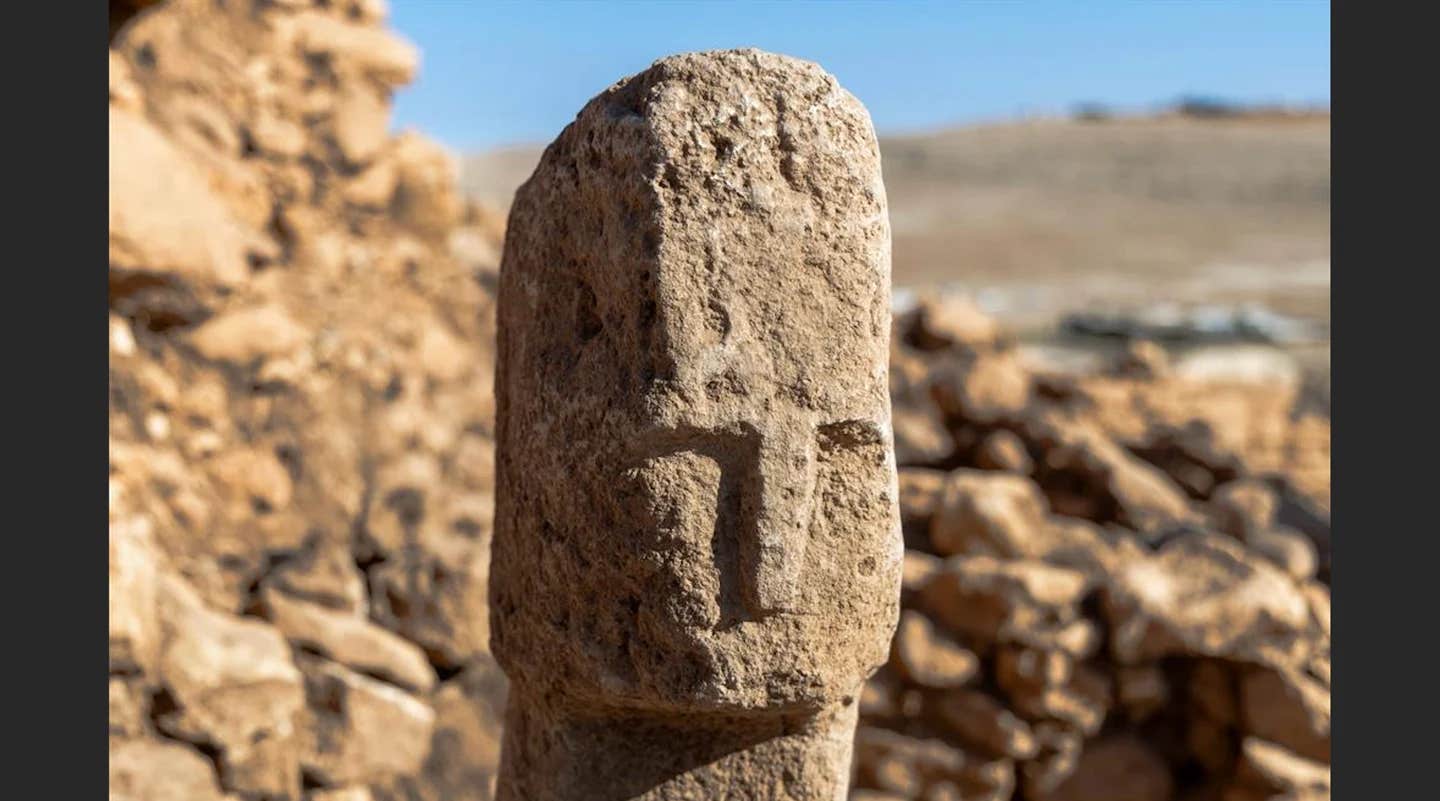Faces of the stone age: Ancient stone obelisk rewrites what we know about art and self-awareness
A carved stone face from Karahantepe may be the world’s earliest self-portrait, reshaping the story of human creativity.

Archaeologists in Turkey have found a 12,000-year-old stone pillar with a carved human face—the oldest known example of self-expression and artistry. (CREDIT: Turkish Ministry of Culture and Tourism)
Archaeologists in south-east Turkey have made an extraordinary find—a prehistoric stone face that might turn everything we believe about the origins of art and self-awareness on its head. In the early Neolithic site of Karahantepe, a T-shaped pillar covered in a carved human face has been unearthed, the first time such a find has been made. The find might be one of humanity's earliest attempts to portray itself—12,000 years ago.
"During the excavations conducted in the context of our Stone Hills Project, a T-shaped obelisk with human face was unearthed for the first time," said Turkish Culture and Tourism Minister Nuri Ersoy. He described the pillar as "the first evidence of the Neolithic man wrapping himself in a T-shaped pillar."
An Ancient City Beneath the Hills
Karahantepe is situated near the Turkish city of Şanlıurfa in the Tek Tek Mountains National Park, which is an area filled with limestone outcrops. It was soft enough to be carved, and the ancient builders turned it into hundreds of monolithic pillars, sculptures, and reliefs.
The newly unveiled face, chiseled into the cap of a T-shaped pillar, recalls the angular features, sunken eye sockets, and broad nose of other human figures found at the location. Its craftsmanship testifies to high technical skill on the part of people who continued to utilize stone tools. Archaeologists describe the work as both artistic and abstract thought—a glimpse into early humans' means of looking at and portraying themselves.
For decades, historians had suspected that the site's T-shaped columns represented individuals, but until now they all lacked distinctive faces. "The obelisks, which were previously believed to symbolize humans, became more meaningful by this discovery," Ersoy said.
Where Art Met Community
Karahantepe, or Karahan Tepe, was first discovered in 1997, but only started to be excavated systemically in 2019. More than 250 of the inscribed pillars and three-dimensional human and animal statues have been found since then. They feature a sad-looking image of a man holding his genitals, one of a person walking with a leopard, and many bird and gazelle representations.
Lead excavator Prof. Necmi Karul explained the human-animal statues reflect a world vision that was blurring distinctions between species. "It is hard to really get the point of what this was trying to say," he told Turkey's Anadolu Agency in an interview, "but it does mean that human–animal relations 11,000 years ago were rather different."
One of the giant structures, about 23 feet wide and carved straight out of bedrock, might have functioned as a communal or ritual space. The collective effort required to carve and move so many large rocks means that workers operated in coordinated groups far earlier than the establishment of cities.
A Sister Site to Göbekli Tepe
Only 22 miles to the west of Karahantepe is Göbekli Tepe, a similarly monumental site more popularly known as the world's oldest temple. The site, built about 11,500 years ago—6,000 years before Stonehenge—sports megalithic pillars ornamented with foxes, leopards, vultures, and snakes. Archaeologists believe that these two places were part of a wider cultural network that transformed hunter-gatherer societies into sedentary societies bound by common ritual.
Dr. Julia Gresky of the German Archaeological Institute, which excavates the site of Göbekli Tepe, said the sheer size of the buildings shows the resolve of their builders. "They must have had a good reason to build it," she said, "which is what makes us think Göbekli Tepe was an early religious site.".
Both Göbekli Tepe and Karahantepe artifacts share the same symbols and construction methods but are distinct with Karahantepe's freestanding sculptures. Whereas Göbekli Tepe includes stylized carvings, there is a jump towards realism in Karahantepe's free-standing sculptures and perhaps an increased sense of individual identity.
The Stone Hills Project
The discovery was during Turkey's ongoing Taş Tepeler, or "Stone Hills," project—a massive undertaking to study 12 ancient settlements over a 200-kilometer stretch of southeastern Anatolia. Led by the Ministry of Culture and Tourism and the Turkish Tourism Promotion and Development Agency, the project aims to find out how early people shared tasks, distributed labor, and were spiritual before literacy and farming.
Only a tiny part of Karahantepe has come to light, but the findings so far suggest it could be more important than Göbekli Tepe. Experts believe both were part of a cluster of cult sites where people gathered to party, grieve, and interpret their place in the world.
These discoveries are being shown at the Şanlıurfa Archaeological Museum, where visitors can see close-up the carved animals and human faces—the individual a tangible reminder of the world's earliest artists.
Practical Implications of the Research
Unveiling Karahantepe's human-faced pillar is more than a historical mystery. It gives researchers hints to follow the trail of symbolic thought—advances in language, religion, and art. Probing how Neolithic societies managed mass construction with rudimentary tools may even rewrite the timeline of social cooperation.
For modern-day Native American scholars, the site bridges the gap between survival and self-expression. It shows that creativity and spirituality did not just happen—all of sudden—they developed slowly, along with communal life.
Future excavations in the Stone Hills region could reveal even more about how our ancestors initially visualized themselves as part of something more than the physical world.
Related Stories
- France's Carnac megalithic site unlocks mysteries of ancient stone structures across Europe
- Stonehenge may have been more than a spiritual site, study finds
- How Easter Island’s moai statues walked themselves into history
Like these kind of feel good stories? Get The Brighter Side of News' newsletter.
Joshua Shavit
Science & Technology Writer and Editor
Joshua Shavit is a Los Angeles-based science and technology writer with a passion for exploring the breakthroughs shaping the future. As a co-founder of The Brighter Side of News, he focuses on positive and transformative advancements in AI, technology, physics, engineering, robotics and space science. Joshua is currently working towards a Bachelor of Science in Business and Industrial Engineering at the University of California, Berkeley. He combines his academic background with a talent for storytelling, making complex scientific discoveries engaging and accessible. His work highlights the innovators behind the ideas, bringing readers closer to the people driving progress.



